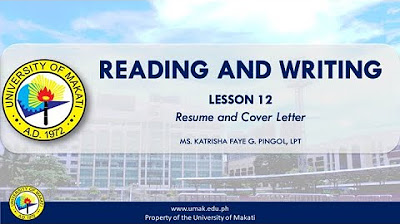MAPA MENTAL - CARTA DO LEITOR (PARTES E CARACTERÍSTICAS)
Summary
TLDRThis video script discusses the structure and purpose of a reader's letter, a concise, subjective, and often persuasive piece of writing. It is typically a response to a news story or report, aiming to provide feedback to the media outlet. The script outlines the common parts of such a letter, including the date, location, salutation, introduction, development, conclusion, and signature. It emphasizes the importance of clear, simple, and objective language to ensure easy understanding. The video also provides tips for writing an effective reader's letter and encourages viewers to subscribe for more educational content.
Takeaways
- 📰 The script discusses the concept of a 'letter to the editor', a genre of writing that is brief, informative, and often persuasive.
- 💬 It emphasizes the importance of clear, simple, and objective language to ensure easy comprehension by the reader.
- 📝 The theme of the letter is current but approached subjectively, meaning it is written in the first person from the perspective of the sender.
- 🗨️ The script explains that newspapers, magazines, or websites reserve a section for feedback from their audience, which is the origin of the term 'letter to the editor'.
- 📅 The script provides an example of a letter dated February 29, 2021, including the location and date to situate the letter in space and time.
- 📑 It outlines the common parts of a letter to the editor, such as the address, greeting, introduction, development, subject, conclusion, and signature.
- 📰 The introduction reveals the motive for writing the letter, often in response to a news article or report published by the media outlet.
- 🤔 The development section shows the reader's opinion, using arguments to support their viewpoint, which can range from positive to negative.
- 🔍 The subject line, in the example given, suggests that more technical details about the crime scene could help uncover the truth.
- 📝 The conclusion may include a suggestion or tip for the media outlet to improve or maintain the quality of its information.
- 🖋️ The script ends with a reminder to subscribe to the channel, activate notifications, and share the knowledge with friends, along with a link to exercises for practice.
Q & A
What is the primary purpose of a letter to the editor?
-The primary purpose of a letter to the editor is to express the writer's opinion on a topic, often related to a recent news article or report, and to engage in a dialogue with the publication and its readers.
What are the characteristics of the language used in a letter to the editor?
-The language used in a letter to the editor should be clear, simple, and objective to ensure easy comprehension.
What is the significance of the date and location in a letter to the editor?
-The date indicates when the letter was written, and the location situates the letter geographically, providing context to the reader.
What is the role of the salutation in a letter to the editor?
-The salutation sets the tone of formality and addresses the intended recipient, which is typically the publication to which the letter is directed.
What is the function of the introduction in a letter to the editor?
-The introduction reveals the reason for writing the letter, often referencing a specific news article or report that the writer is responding to.
How does the development section of a letter to the editor differ from the introduction?
-The development section expands on the writer's opinion, providing arguments and details to support their viewpoint, whereas the introduction simply states the reason for writing.
What is the purpose of the conclusion in a letter to the editor?
-The conclusion may offer suggestions or advice to the publication to improve or maintain the quality of its information, although it is not mandatory and can be omitted.
What determines the formality of the closing and signature in a letter to the editor?
-The formality of the closing and signature depends on the relationship between the writer and the publication, which can range from formal to colloquial.
Why might a publication choose to omit the conclusion of a letter to the editor?
-A publication might omit the conclusion due to space constraints or if the writer's suggestions are not deemed relevant or necessary.
What is the significance of the feedback section in a newspaper, magazine, or website?
-The feedback section is important as it allows the publication to receive and incorporate the public's opinions and reactions to improve and better serve its readers.
What does the term 'letter to the editor' originate from?
-The term 'letter to the editor' originates from the English language and refers to the result that a communication medium needs to improve its information and better cater to its readers.
Outlines

Cette section est réservée aux utilisateurs payants. Améliorez votre compte pour accéder à cette section.
Améliorer maintenantMindmap

Cette section est réservée aux utilisateurs payants. Améliorez votre compte pour accéder à cette section.
Améliorer maintenantKeywords

Cette section est réservée aux utilisateurs payants. Améliorez votre compte pour accéder à cette section.
Améliorer maintenantHighlights

Cette section est réservée aux utilisateurs payants. Améliorez votre compte pour accéder à cette section.
Améliorer maintenantTranscripts

Cette section est réservée aux utilisateurs payants. Améliorez votre compte pour accéder à cette section.
Améliorer maintenantVoir Plus de Vidéos Connexes

[LETTER TEMPLATE] How To Write An Inquiry Letter Step by Step Guide | Writing Practices

Subjective and Objective Writing Styles||DrWaheedjatoi||

BEWERBUNGSSCHREIBEN I wie du schon im Anschreiben überzeugst! 🚀 I Traumjob

Lesson 12: Resume and Cover Letter | Reading and Writing

Creative Writing Characteristics~GM Lectures

HORTATORY EXPOSITION TEXT | KELAS 12 | KURIKULUM MERDEKA |
5.0 / 5 (0 votes)
